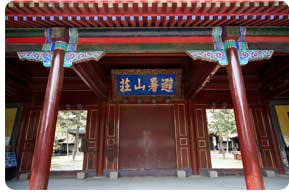 Chengde is located 250 kilometers north-east to Beijing, surrounded by the Yanshan mountain range. It is a famous cultural city with about 300 years history, used to be the second political center in the Qing dynasty, with the largest extant royal garden in China. Chengde is located 250 kilometers north-east to Beijing, surrounded by the Yanshan mountain range. It is a famous cultural city with about 300 years history, used to be the second political center in the Qing dynasty, with the largest extant royal garden in China.
Brief Introduction of Chengde
Chengde is a famous historical and cultural city. It is situated in Hebei Province and has an area of 4,471 square kilometers and a population of 88.5 million. Located some 250 km northeast of Beijing, Chengde offers a nice, cool alternative to the summer heat of the capital.
Chengde scenic sights include: Putuozongsheng (Potala) Palace which is the largest and most impressive of the Chengde palaces was built in 1790 by Qianlong for his 60th birthday. Xumifushou Temple which was built in 1781 in honour of the sixth Panchen Lama. It is an imitation of a temple in Shigatse and combines Tibetan and Han architecture. The highest point features a hall with eight copper dragons, giving the roof an impressive look. Pule Temple, built in 1776 for visits of minorities, among them Kazaks, this temple features an unusual Round Pavilion that resembles Beijing's Temple of Heaven. Puning Temple which was built by Qianlong to commemorate his victory over the Mongols. A stele describes the events in Chinese, Manchu, Tibetan and Mongol. The temple itself is modeled on a Tibetan temple. It features a 22 m high Buddha, with 42 arms and an eye on each palm. The temples has been listed into the World Culture Heritage.
Chengde is a famous cultural city with about 300 years history; It used to be the second political center in the Qing dynasty, with the largest extant royal garden in China. Chengde was commonly called "Rehe", for the sake of having the ever flowing and unfrozen spring here. The Imperial Summer Villa and the Eight Outer Temples are very famous scenic spots of China. The special locally-made products are silk products, glass ware, and tinned food.
Chengde lies in the northeast of Hebei province. It Neighbors on Beijing, Tianjin, Liaoning, Inner Mongolia, and borders Tanshan, Qinhuangdao and Zhangjiakou. It is not far from the Bohai Bay to the southeast. Shuangqiao District, where the municipal government is situated, is 224 kilometers from Beijing, 200 kilometers from the Capital Airport, 320 kilometers from Tianjin, 360 kilometers from Tianjin, 360 kilometers from Qinhuangdao and 526 kilometers from Shijiazhuang, the capital of the province.
Chengde is a city under the domination of Hebei provincial government. It includes 3 districts: Shuangqiao, shuangluan and Yingshouyingzi; 8 counties-Weichang, Fengning, Kuancheng, Longhua, Luanping, Chengde, Pingquan and Xinglong, among which Weichang is a Manchu and Mongolian autonomous county, Fengning and Kuancheng are Manchu and Mongolian autonomous counties. Shuangqiao District, the seat of the municipal government, is the political, economical and cultural center of city.
Chengde lies in the northeast of Hebei province. It Neighbors on Beijing, Tianjin, Liaoning, Inner Mongolia, and borders Tanshan, Qinhuangdao and Zhangjiakou. It is not far from the Bohai Bay to the southeast. Shuangqiao District, where the municipal government is situated, is 224 kilometers from Beijing, 200 kilometers from the Capital Airport, 320 kilometers from Tianjin, 360 kilometers from Tianjin, 360 kilometers from Qinhuangdao and 526 kilometers from Shijiazhuang, the capital of the province.
Regionalism
Chengde is a city under the domination of Hebei provincial government. It includes 3 districts: Shuangqiao, shuangluan and Yingshouyingzi; 8 counties-Weichang, Fengning, Kuancheng, Longhua, Luanping, Chengde, Pingquan and Xinglong, among which Weichang is a Manchu and Mongolian autonomous county, Fengning and Kuancheng are Manchu and Mongolian autonomous counties. Shuangqiao District, the seat of the municipal government, is the political, economical and cultural center of city.
Tourist resources in Chengde are the richest of the whole province, including 8 state-level protected cultural relic sites, 35 province-level protected cultural relic sites, 30 natural scenic spots, 20 forest parks, state-level nature-protected zones and folk vacation zones. Chengde Mountain Resort is the largest royal garden exiting in the world, and the Eight Outer Temples is the Largest temple group in the world.
With the development of the opening to the outside world, tourist industry has developed rapidly. Not only that the Mountain Resort and the Eight Outer Temples and the other surrounding natural scenic spots have been improved in many ways, but also that the tourist places have been extended in all directions into the counties. The Golden Line for Tour and the Beijing-Chaoyang Line for Tour have been perfected. Around the two lines, different tourist systems have appeared, such as "Puningsi Temple Worship Tour" , been installed."Panjiakou Park on Water", etc. With the development of the tourist resources, the tourist industries are also developing very fast. Now there are 50 hotels for foreigners, 25 star-level hotels, 65 travel services. A group of
high-level interpreter guides has turned out. The basic equipments connecting with "eating, lodging, traffic, sightseeing, shopping and recreation services:" have been installed.
|



